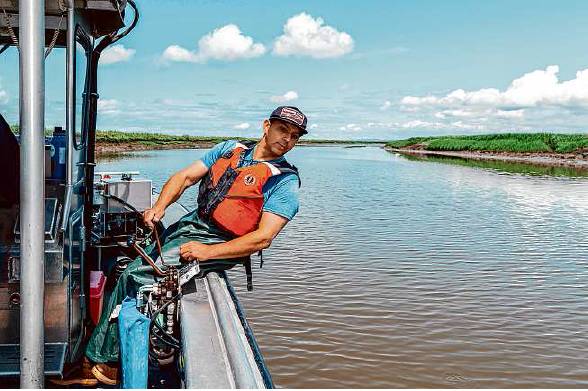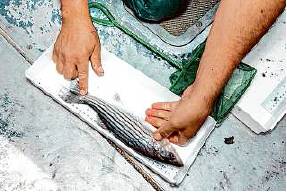Wealth of rain, snow boosting bay’s health
Fast-moving water flowing in removes pollutants, benefits fish
By Tara Duggan
Full of cold, fresh rainwater and snowmelt from the Sierra, San Francisco Bay is in a strikingly different place than it was last summer.
Water gushing out of the delta is flushing out pollutants and contaminants and giving endangered baby salmon a helpful push into the ocean. Longfin smelt and yellow-fin gobies are spawning in the usually swampy southern end of the bay, and sediment coming in from mountain streams is replenishing the structure of its basin.
Just eight months ago, the bay was murky brown and its perimeters were piled with dead fish. Unprecedented in known Bay Area history, a harmful algae bloom that followed three years of drought killed off thousands of long-lived sturgeon and smaller fish.
The current onslaught of fresh water could help prevent a repeat of such an event.
“We’re not at risk today of having a harmful algae bloom given the conditions in the bay,” said Eileen White, executive officer of the San Francisco Bay Regional Water Quality Control Board. “And we know that there’s going to be massive runoff with the snowmelt. So we’re very lucky.”
“It seems that there’s evidence that the system is fairly resilient.”
Levi Lewis, UC Davis researcher
But despite current conditions, White and others expect to see more such red tides in the future if more isn’t done to prevent them. Climate change is expected to cause unusual weather patterns that shift the balance toward more harmful algae blooms — some that could be harmful to humans and other animals, not just fish.
For now, endangered young king salmon are benefiting from the flow of fresh water to help them migrate from their native rivers through the bay and into the ocean. That advantage is offset by the fact that this year’s cohort of baby salmon were born during the drought, however, and their numbers are very low as a result.
UC Davis researchers are finding plenty of longfin smelt, gobies and herring in monthly surveys of the bay, researcher Levi Lewis said. A fisherman himself, he notes that sport-fishing for halibut in the bay is doing well, too.
“There are fish still in the bay. The whole bay didn’t die,” he said. “It seems that there’s evidence that the system is fairly resilient.”
During a meeting of the San Francisco Regional Water Board on Wednesday, White and scientists who study the bay presented theories about how last year’s algae bloom, which first appeared in July near Alameda and spread throughout the bay through August, turned so deadly.
They think the fish were killed both by toxins from the algae and later by hypoxia, or lack of oxygen in the water after the bloom spread, White said in an interview.
“Last year we had the perfect conditions — we had multiyear drought conditions coupled with multiple days of sun, with little wind and fog, and that allowed this algae bloom to form and spread,” White said.
The nutrients that fueled the bloom come from 37 sewage plants that release treated wastewater into the bay. Though the water is treated for pathogens, it contains nitrogen that feeds organisms that can grow into huge, harmful algae blooms in the right conditions — including lots of sunlight and higher water temperatures.
Lewis likened the high levels of nitrogen in the bay to an overgrown forest at risk of wildfire.
“In San Francisco Bay we keep pumping in the nitrogen. It’s almost like letting the undergrowth grow. It’s waiting for a spark,” he said.
What’s different this year is that all the fresh water coming into the bay from the Sacramento and the San Joaquin rivers “rushing like a firehose out of the delta” is probably pushing the tiny bloom-forming organisms out of the bay, as well as the nutrients that feed them, said Jon Rosenfield, senior scientist at the conservation group San Francisco Baykeeper.
The rain and snowmelt deposit sediments that help keep the water turbid, or cloudy, preventing bloom-causing sunlight to penetrate. High levels of salt and higher water temperatures also help cause a bloom, another reason that the current fresh, cool water is favorable.
Wastewater treatment plants could remove nutrients from the water they discharge in the bay, but it could cost an estimated $14 billion to upgrade aging facilities. The plants are all under a permit from the San Francisco Bay Regional Water Quality Control Board that expires next year. The water board has indicated that it will probably require the plants to upgrade equipment under the new permit.
Lewis said what was most “horrifying” about the algae bloom was that it killed an estimated 800 white sturgeon, or a significant portion of the population of fish, and 20 green sturgeon, which are under threatened status. After an urging by Lewis and other scientists, the California Department of Fish and Wildlife is holding a meeting this week to discuss the future of white sturgeon sports fishing in the bay.
Lewis noted that white sturgeon can live 20 to 100 years under normal conditions.
“It’s like a redwood tree that is able to survive fires,” he said. “If something takes them out, it’s a concern.”
Reach Tara Duggan: tduggan@sfchronicle.com;
Twitter: @taraduggan
“We’re not at risk today of having a harmful algae bloom given the conditions in the bay. And we know that there’s going to be massive runoff with the snowmelt. So we’re very lucky.”
Eileen White, executive officer of the San Francisco Bay Regional Water Quality Control Board


